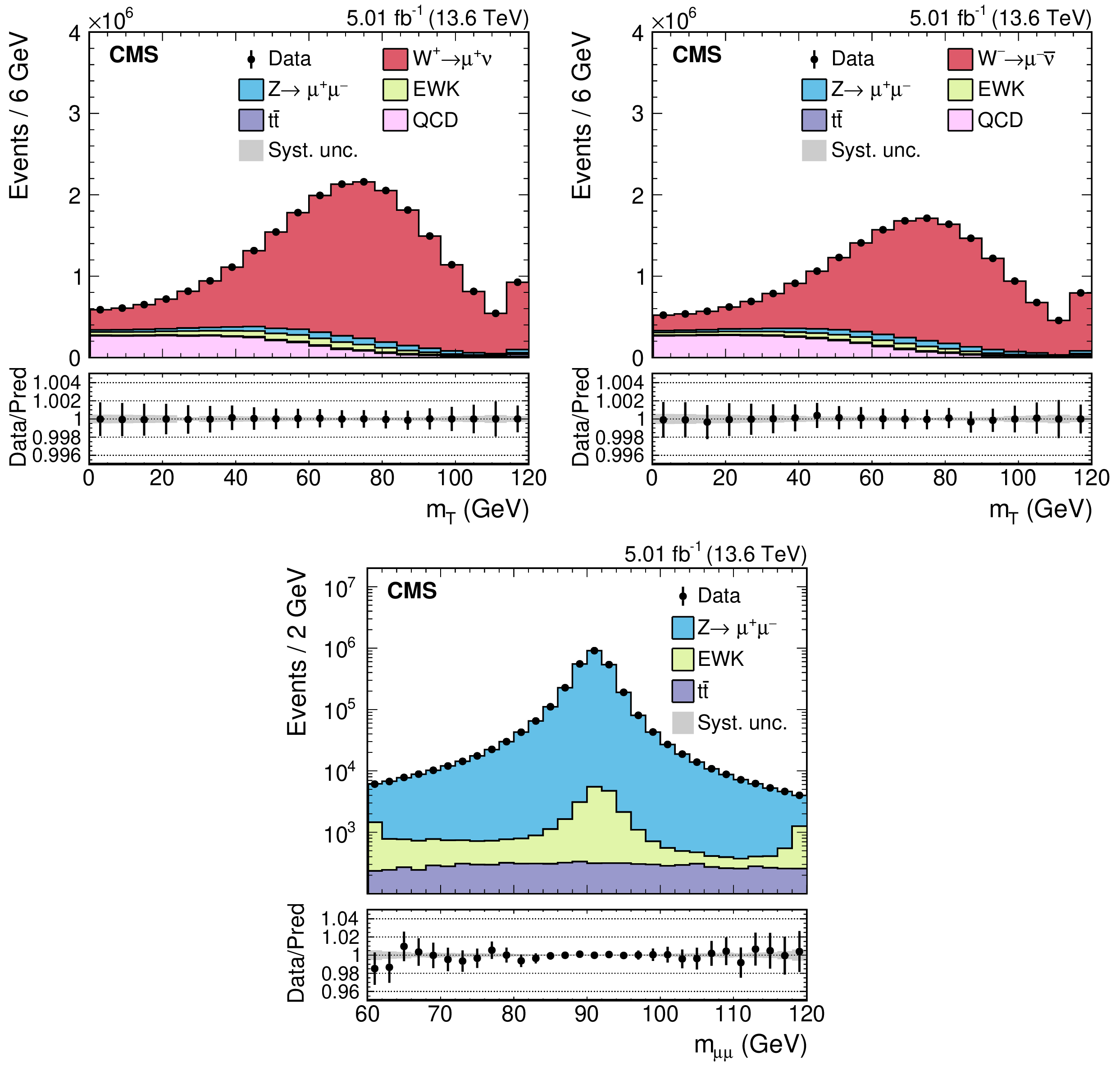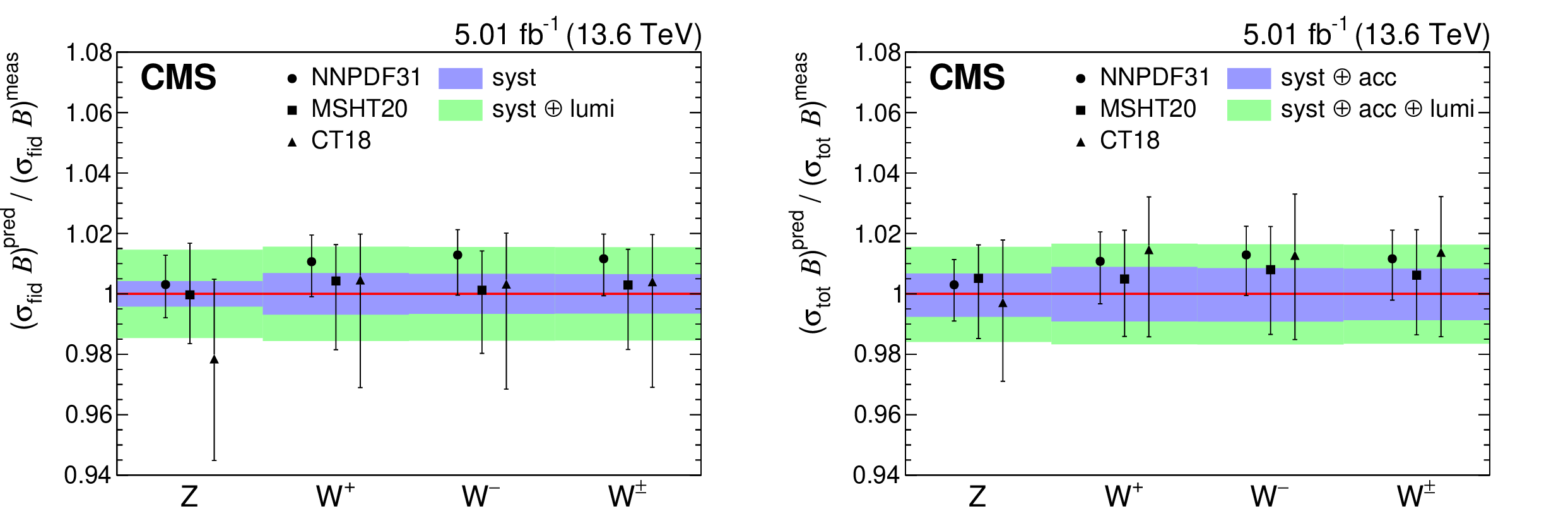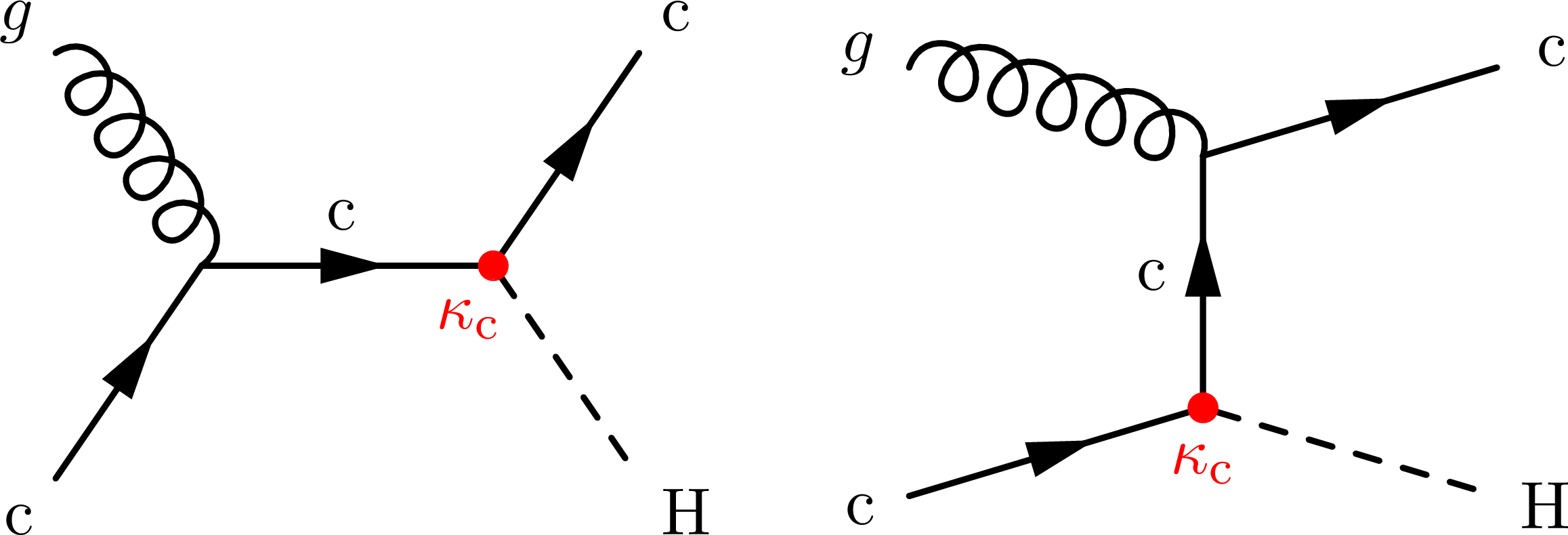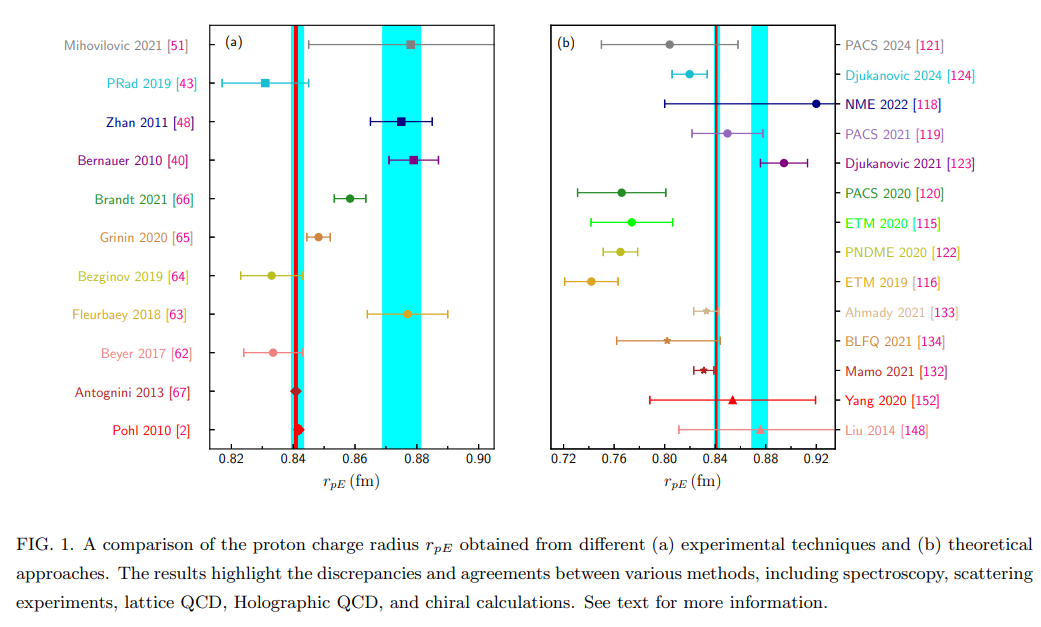Mar 17th, 2025
CMS-SMP-22-017
Measurements are presented of the W and Z boson production cross sections in proton-proton collisions at a center-of-mass energy of 13.6 TeV. Data collected in 2022 and corresponding to an integrated luminosity of 5.01 fb−1 with one or two identified muons in the final state are analyzed. The results for the products of total inclusive cross sections and branching fractions for muonic decays of W and Z bosons are 11.93 ± 0.08 (syst) ± 0.17 (lumi) +0.07−0.07 (acc) nb for W+ boson production, 8.86 ± 0.06 (syst) ± 0.12 (lumi) +0.05−0.06 (acc) nb for W− boson production, and 2.021 ± 0.009 (syst) ± 0.028 (lumi) +0.011−0.013 (acc) nb for the Z boson production in the dimuon mass range of 60-120 GeV, all with negligible statistical uncertainties. Furthermore, the corresponding fiducial cross sections, as well as cross section ratios for both fiducial and total phase space, are provided. The ratios include charge-separated results for W boson production (W+ and W−) and the sum of the two contributions (W±), each relative to the measured Z boson production cross section. Additionally, the ratio of the measured cross sections for W+ and W− boson production is reported. All measurements are in agreement with theoretical predictions, calculated at next-to-next-to-leading order accuracy in quantum chromodynamics.
CMS-SMP-22-017

CMS-SMP-22-017

CMS-SMP-22-017


CMS-SMP-22-017


The CMS Collaboration, JHEP 05 (2023) 233 arXiv:2204.12945
Results are presented from a search for the Higgs boson decay H → Zγ, where Z → ℓ+ℓ− with ℓ = e or μ. The search is performed using a sample of proton-proton (pp) collision data at a center-of-mass energy of 13 TeV, recorded by the CMS experiment at the LHC, corresponding to an integrated luminosity of 138 fb−1. Events are assigned to mutually exclusive categories, which exploit differences in both event topology and kinematics of distinct Higgs production mechanisms to enhance signal sensitivity. The signal strength μ, defined as the product of the cross section and the branching fraction [σ(pp → H)B(H → Zγ)] relative to the standard model prediction, is extracted from a simultaneous fit to the ℓ+ℓ−γ invariant mass distributions in all categories and is found to be μ = 2.4 ± 0.9 for a Higgs boson mass of 125.38 GeV. The statistical significance of the observed excess of events is 2.7 standard deviations. This measurement corresponds to σ(pp → H)B(H → Zγ) = 0.21 ± 0.08 pb. The observed (expected) upper limit at 95% confidence level on μ is 4.1 (1.8). The ratio of branching fractions B(H → Zγ)/B(H → γγ) is measured to be 1.5 +0.7−0.6, which agrees with the standard model prediction of 0.69 ± 0.04 at the 1.5 standard deviation level.
The ATLAS Collaboration, Phys. Lett. B 809 (2020) 135754 , arXiv:2005.05382
A search for the Zγ decay of the Higgs boson, with Z boson decays into pairs of electrons or muons is presented. The analysis uses proton−proton collision data at s√ = 13 TeV corresponding to an integrated luminosity of 139 fb−1 recorded by the ATLAS detector at the Large Hadron Collider. The observed data are consistent with the expected background with a p-value of 1.3%. An upper limit at 95% confidence level on the production cross-section times the branching ratio for pp→H→Zγ is set at 3.6 times the Standard Model prediction while 2.6 times is expected in the presence of the Standard Model Higgs boson. The best-fit value for the signal yield normalised to the Standard Model prediction is 2.0+1.0−0.9 where the statistical component of the uncertainty is dominant.
Aliaksei Kachanovich
The ATLAS and CMS Collaborations reported that the observed number of Higgs boson decays into a Z boson and a photon is μ=2.2±0.7 times higher than predicted by the Standard Model. Initially, this discrepancy was attributed to a modification of the HZγ vertex. In the H→Zγ process, this decay is reconstructed from H→ℓℓγ, where ℓ represents either an electron or a muon. In this study, an investigation is conducted to examine this anomaly by exploring potential additional background contributions to H→ℓℓγ from various subprocesses within and beyond the Standard Model.
A. Kachanovich, J. Kimus, S. Lowette, M. H.G. Tytgat
Motivated by a small but intriguing excess observed in the decay mode H→ℓ+ℓ−γ reported by both the ATLAS and CMS collaborations, we explore the possibility that new physics contributes directly to the effective Hℓℓγ coupling rather than modifying the Z peak. Concretely, we consider a dimension-8 operator that could arise from new particles via box diagrams. Such non-resonant contribution may provide an alternative origin for current or future excesses. We examine how experimental cuts may distinguish between possible modifications of the Z peak and non-resonant contributions. The currently measured excess requires that the new physics scale is relatively low (ΛR∼v). However, we show that it may remain within current experimental bounds. In particular, we illustrate this using a simplified model, motivated by the dark matter problem, and discuss its other experimental constraints.
CMS-HIG-23-010
This paper presents the first search for the associated production of a Higgs boson with a charm quark (cH), with the Higgs boson decaying to two photons. Associated cH production provides an opportunity to probe the coupling of the Higgs boson to charm quarks. The results are based on a data set of proton-proton collisions at a center-of-mass energy of 13 TeV collected with the CMS experiment at the LHC, corresponding to an integrated luminosity of 138 fb−1. Assuming the standard model (SM) rates for all other Higgs boson production processes, the observed (expected) upper limit at 95% confidence level on the cH signal strength is 243 (355) times the SM prediction. Under the same assumption, the observed (expected) allowed interval on the Higgs boson to charm quark coupling modifier, κc, is |κc| < 38.1 (|κc| < 72.5) at 95% confidence level.

The MMGPDs Collaboration
The concept of nucleon radii plays a central role in our understanding of the internal structure of protons and neutrons, providing critical insights into the non-perturbative regime of quantum chromodynamics (QCD). While the charge radius is often interpreted as the ``size" of the nucleon, this interpretation is an oversimplification that overlooks the multifaceted nature of nucleon structure. This paper provides a comprehensive overview of the different nucleon radii, including the charge and magnetic radii, the axial radius, and the emerging concepts of mechanical and mass radii. We discuss the definitions as well as the experimental, theoretical and phenomenological determinations of these radii, highlighting their distinct physical origins and implications. By synthesizing recent experimental results and theoretical advancements, we emphasize that each radius reflects a specific aspect of the nucleon's internal structure, such as its electric charge distribution, magnetic properties, weak interactions, or internal mechanical stress. In particular, we address the common but misleading interpretation of the proton radius as a simple measure of its size, underscoring the nuanced and context-dependent nature of nucleon radii. Through this exploration, we aim to clarify the roles of these radii in characterizing nucleon structure and to identify open questions that remain to be addressed. This work contributes to a deeper understanding of the nucleon and its significance in the broader context of particle and nuclear physics.
The MMGPDs Collaboration

The MMGPDs Collaboration

I. Bigaran et al
We propose a dark matter direct-detection strategy using charged particle decays at accelerator-based experiments. If ultralight ( mϕ ≪ eV ) dark matter has a misalignment abundance, its local field oscillates in time at a frequency set by its mass. If it also couples to flavor-changing neutral currents, rare exotic decays such as μ→eϕ and τ→e(μ)ϕ inherit this modulation. Focusing on such charged lepton flavor-violating decays, we show that sufficient event samples can enable detection of ultralight dark matter candidates at Mu3e, Belle-II, and FCC-ee.
CMS-SUS-23-015
A first search for beyond the standard model physics in jet scaling patterns of multilepton events is presented, using a data sample corresponding to an integrated luminosity of 138 fb−1 of 13 TeV proton-proton collisions recorded by the CMS detector at the LHC. The search uses observed jet multiplicity distributions in one-, two-, and four-lepton events to explore possible enhancements in jet production rate in three-lepton events with and without bottom quarks. The data are found to be consistent with the standard model expectation. The results are interpreted in terms of supersymmetric production of electroweak chargino-neutralino superpartners with cascade decays terminating in prompt hadronic R-parity violating interactions.